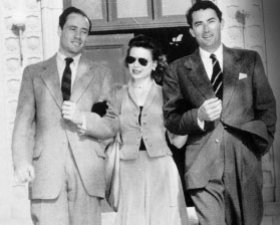The French Line
(1954) pairs Jane Russell and Gilbert Roland on a transatlantic voyage. He’s a playboy Frenchman, she’s a wealthy
Texan incognito trying to find somebody who’ll love her for herself and not her
money.
There were other, more tawdry taglines to this Howard
Hughes-produced film, originally shown in theaters in 3-D to more fully capture
Jane’s most publicized attributes. To
her credit, her likeably good-old-gal charm rises above the costumes and dance
routines designed to keep her bra size the main focus.
I had been meaning to cover this one sometime or other, but
was spurred to move it up in the queue from the recent mention in the excellent
TCM interview of Kim Novak, noting that this was her film debut. She’s a chorus girl, and if you blink, you
miss her. She's on the left in this shot.
Other bit roles by actors who never quite reached Miss Novak’s
fame include Charles Smith, who shows up as a reporter. We’ve met him before in Dive Bomber here, and The Shop Around the Corner here.
Kasey Rogers, who you’ll remember best as Louise Tate on TV’s
Bewitched shows up as Jane Russell’s
newly-married pal, whose marital bliss leaves Jane envious.
Our old pal Arthur Hunnicutt, who we saw here at a
prospector galoot in Split Second,
shows up as an oil wildcatting galoot, and Jane’s guardian. He’s a loveable old cuss, but a bit too
loud. HE SHOUTS EVERY LINE.
Craig Stevens has a minor role as Jane’s swell guy fiancé who
breaks off the wedding because he’s too intimated by her money. A pal reminds Jane, “You’ve been a
corporation since you were three.”
This is Jane’s tale of woe.
Men are either attracted by her money, or overwhelmed by it.
Miss Russell sheds her Texas blue jeans and boots, and heads
to New York to meet her buddy, fashion designer Mary McCarty, and heads with
her to Paris. McCarty’s on business to
take her new line to a fashion show, and Jane pretends to be one of her models.
It’s a pleasure to see Mary McCarty in a comic relief
role. She pulls out a bottle of booze
from her desk drawer and offers it to Jane, “Tea, darling?” She’s probably more well known to theatre
buffs, including a featured role in Follies in 1971, and a Tony nomination
for Anna Christie in 1977.
Bess Flowers plays one of the sales ladies in her shop. Go Bess!
The film is famous for getting into trouble with the Breen
Office and with the Catholic National Legion of Decency. It’s been cut and censored here and there,
and the version you might see on TCM is considered the edited version. One uncensored excerpt of Jane’s “Lookin’ forTrouble” number is here on YouTube.
The songs are mostly cute. Jane bebops in a duet with her maid, Theresa
Harris, with several peek-a-boo moments as she’s bathing. Unfortunately, there’s no duet with Gilbert
Roland, and there should be.
He’s my favorite part of the movie. We’d noted his virile charm here in We Were Strangers. Mr. Roland’s charming manner and smooth, rich
baritone are really quite beautiful in “Wait Till You See Paris”, which he
croons to Jane on shipboard—one of those movie moonlit nights, with couples
gazing at the water over the ship’s rail.
“With a Kiss” is a kick-your-heels-up number he performs in
a hotel room full of female fans, but my favorite is “Comment Allez Vous,” which is a sweet, waltz-time melody he croons with lullaby softness to a couple
of kids fighting over a toy music box.
It’s really a lovely song, and he could have used it just as capably to
seduce Jane as to quiet a couple of noisy kids.
The ship they’re sailing on is the Liberté, (French Line, of course), which had a busy year in 1954,
as I think that was the same ship Audrey Hepburn took to France in Sabrina, which we covered here.
As long as we’re on the subject of Audrey Hepburn, their trip
to Paris to attend a fashion show reminds one of Miss Hepburn’s voyage to Paris
for the same purpose in Funny Face
(1957).
Also, there’s a shot in The French Line at the fashion show
where a couple of guys toss rolls of fabric right at the camera, just like Kay
Thompson did so famously in Funny Face. I think Kay did it better. She had a good arm, and lots of pizzazz.
There’s a subplot involving mistaken identities, and a bit
where Mr. Roland attempts to cure Jane’s “mal de mer” with a mixture of stout
and champagne, which he says will also cure asthma and chicken pox.
A frothy film, that could have been better with closer
attention to the romance between the easy-going playboy and the reluctant
heiress, but still worth it if only to swoon over Gilbert Roland.
A photo of a sticker I noticed once on an old suitcase....
*********
Jacqueline T. Lynch
is the author of Ann Blyth: Actress.
Singer. Star. and Memories
in Our Time - Hollywood Mirrors and Mimics the Twentieth Century. Her newspaper
column on classic films, Silver Screen, Golden Memories is syndicated
nationally.




























